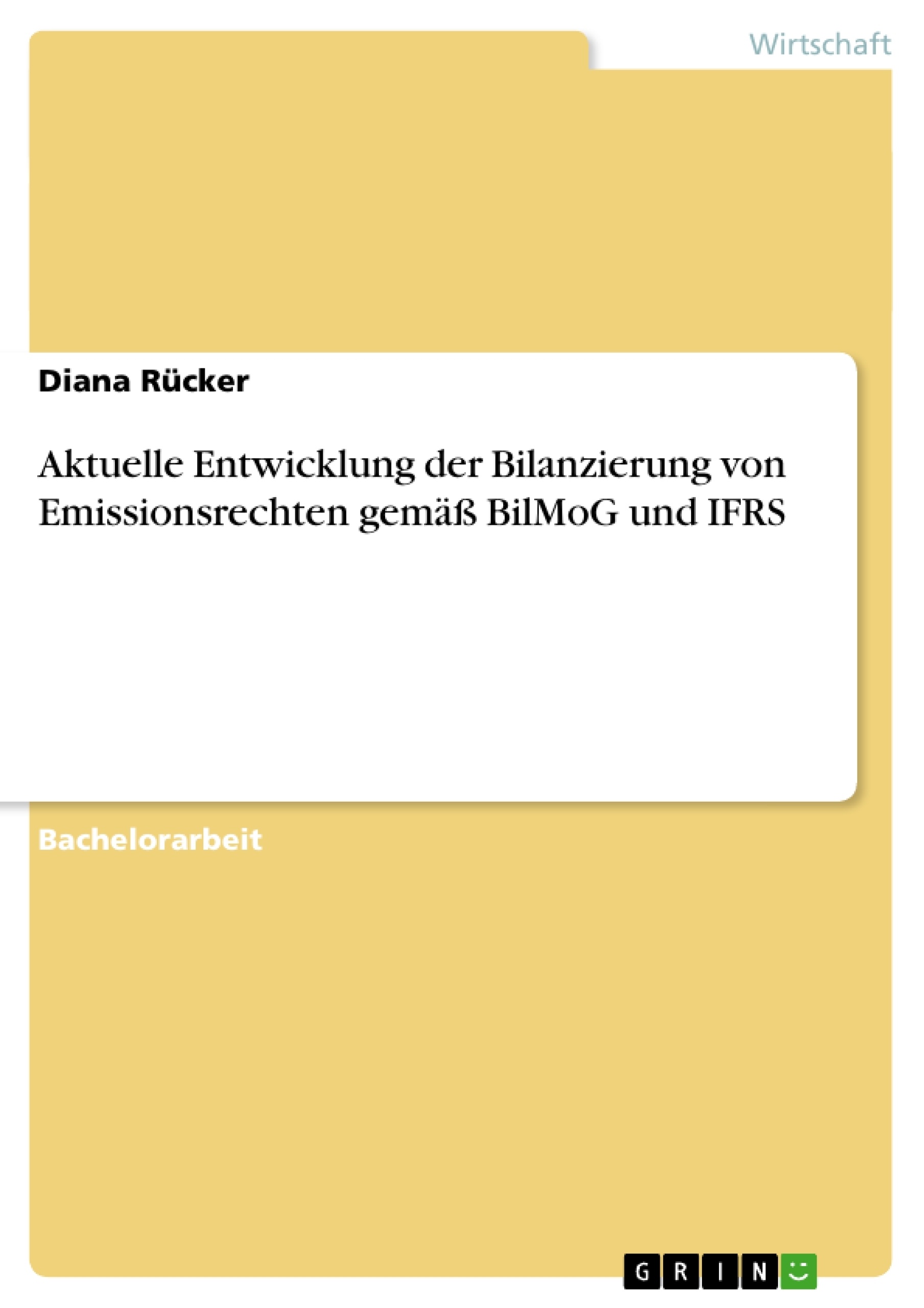Ziel dieser Arbeit ist es, die Grundlagen des Emissionshandels sowie die bilanzielle Behandlung von Emissionsberechtigungen nach dem nationalen Handelsrecht und den internationalen Regelungen der IAS/IFRS darzustellen. Dabei werden zuerst die rechtlichen Grundlagen sowie die Umsetzung des Emissionshandels aufgezeigt und die ersten Handelsperioden näher betrachtet. Anschließend wird im dritten Kapitel die Bilanzierung von Emissionsrechten nach den Regelungen des Handelsgesetzbuches (HGB) vorgestellt und auf entstandene Neuregelungen durch das BilMoG näher eingegangen. Im vierten Kapitel wird dann die Bilanzierung von Emissionsrechten nach den internationalen Rechnungslegungsstandards der IAS/IFRS untersucht und mögliche Lösungen, die mit den aktuellen Standards konform sind, werden aufgezeigt. Um die theoretischen Ausführungen zu veranschaulichen, befindet sich im Anhang dieser Arbeit jeweils ein Fallbeispiel zur Bilanzierung nach HGB/BilMoG und nach IFRS. Ausgehend von den Überlegungen im theoretischen Teil der Arbeit werden abschließend im fünften Kapitel verschiedene Geschäftsberichte der Jahre 2005 bis 2008 dahin gehend analysiert, wie die Emissionsberechtigungen in den Jahresabschlüssen, bestehend aus Bilanz, Gewinn- und Verlustrechnung (GuV), sowie Anhang und Lagebericht abgebildet werden und ob eine Verbesserung der Darstellung von Emissionsrechten in Geschäftsberichten erkennbar ist.
1
Whenever a new Disney film is released, millions of people, children as well as adults, rush to the movie theatre to see it. Disney films are much liked by old and young people alike. Very frequently, they use already commonly known plots and give them a new shape. Their repertoire covers many fairy tales and legends. One of these legends to be found in the Disney film collection is the story of Mulan 1 , the story of a Chinese girl, who, disguised as a man, takes her father’s place in the Chinese army and helps defend China against the Huns. She does this to preserve the honor of the family. This old Chinese legend has, as is true for most of the Disney productions, been changed and made suitable for the (white) American market of family entertainment.
The China portrayed in the original version of the legend of Mulan, or rather the children’s book that was available to me in our course reader2, is a pretty accurate description of what ancient China must have been like. However, for the audience this children’s book is probably aimed at, i.e. an audience with a Chinese background3, Chinese culture is nothing extraordinary, so the culture is not highlighted in any way. In this book, Mulan has been trained in martial arts by her father from very early in her childhood. Moreover, she has a brother whose name she takes on when taking her father’s place in the war against the intruders. In other words, Mulan has been given her martial arts skills as well as a name from a man, she has not acquired or created them herself. When she leaves, she leaves her home with the permission of her parents. Due to her knowledge of martial arts and her intelligence, she is soon admired by all of the soldiers and becomes a commanding general
2
during a war of more than ten years. There is no one there to either protect her or assist her with advices. In the end, this very strategically oriented general uses the superstition of her enemies, which are not the Huns but simply “enemies from the north,” against them and defeats them. She wins without failing first, and it is only in the end that everyone finds out that she is actually a woman, and no one feels offended about it. The possible message of this legend may be the importance of honor in ancient China, which has to be defended against the enemy, no matter who this enemy may be.
The Disney version, in contrast, presents an assertive female lead who engages in action, acquires her skills by perseverance. She is more like a Chinese American version4 of the original Mulan, a young woman who fights a war against prejudice and who ends up falling in love. The battle she has to fight, however, seems much shorter than is described in the original legend. This may be attributed to the pace of life in America, which is by far faster than elsewhere on the world. In addition to that, the love story plot and some characters have been added to the Disney version. These characters, such as Mulan’s grandmother and Mushu, basically make the whole story funnier. Finally, Disney does not seem to bother much about historical accuracy: the enemy, in this version, are the Huns. However, it is widely known that China has been attacked by some Mongolian tribes, but not the Huns. This seems to imply that it doesn’t really matter which Mongolian tribe invaded China, since they are all seen to be exchangeable for, to the white American eye5, they all look alike.
[...]
1 Throughout this essay I will stick to the spelling “Mulan” even though in the book I am comparing the Disney version with the name is spelled “Mu-Lan.”
2 It is very likely that this children’s book version of the legend of Mulan has equally been altered in order to be a story suited for children.
3 I concluded this from the bilingual text.
4 In a similar way, the Walt Disney version of Aladdin shows rather an Arab American leading character than an Arab one.
5 It is not my intention to create a stereotype for what I call “white American.” This term is meant to cover all those who have bought into the media’s portrayal of Asian Americans and the stereotypes existing in America. Likewise, the term “Asian American” is a term that covers all the diverse groups of people of Asian ancestry in America.
- Quote paper
- Diana Rücker (Author), 2009, Aktuelle Entwicklung der Bilanzierung von Emissionsrechten gemäß BilMoG und IFRS, Munich, GRIN Verlag, https://www.grin.com/document/138092



